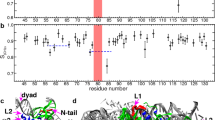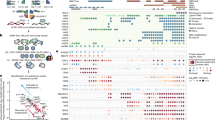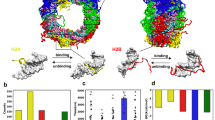Abstract
Post-translational modifications of the histone tails are correlated with distinct chromatin states that regulate access to DNA. Recent proteomic analyses have revealed several new modifications in the globular nucleosome core, many of which lie at the histone-DNA interface. We interpret these modifications in light of previously published data and propose a new and testable model for how cells implement the histone code by modulating nucleosome dynamics.
This is a preview of subscription content, access via your institution
Access options
Subscribe to this journal
Receive 12 print issues and online access
$209.00 per year
only $17.42 per issue
Buy this article
- Purchase on SpringerLink
- Instant access to full article PDF
Prices may be subject to local taxes which are calculated during checkout



Similar content being viewed by others
References
Narlikar, G.J., Fan, H.Y. & Kingston, R.E. Cooperation between complexes that regulate chromatin structure and transcription. Cell 108, 475–487 (2002).
Strahl, B.D. & Allis, C.D. The language of covalent histone modifications. Nature 403, 41–45 (2000).
Fischle, W., Wang, Y. & Allis, C.D. Binary switches and modification cassettes in histone biology and beyond. Nature 425, 475–479 (2003).
Cocklin, R.R. & Wang, M. Identification of methylation and acetylation sites on mouse histone H3 using matrix-assisted laser desorption/ionization time-of-flight and nanoelectrospray ionization tandem mass spectrometry. J. Protein Chem. 22, 327–334 (2003).
Zhang, K. et al. Identification of acetylation and methylation sites of histone H3 from chicken erythrocytes by high-accuracy matrix-assisted laser desorption ionization-time-of-flight, matrix-assisted laser desorption ionization-postsource decay, and nanoelectrospray ionization tandem mass spectrometry. Anal. Biochem. 306 259–269 (2002).
Zhang, L., Eugeni, E.E., Parthun, M.R. & Freitas, M.A. Identification of novel histone post-translational modifications by peptide mass fingerprinting. Chromosoma 112, 77–86 (2003).
Freitas, M.A., Sklenar, A.R. & Parthun, M.R. Application of mass spectrometry to the identification and quantification of histone post-translational modifications. J. Cell Biochem. 92, 691–700 (2004).
Hansen, J.C. Conformational dynamics of the chromatin fiber in solution: determinants, mechanisms, and functions. Annu. Rev. Biophys. Biomol. Struct. 31, 361–392 (2002).
Luger, K. Structure and dynamic behavior of nucleosomes. Curr. Opin. Genet. Dev. 13, 127–135 (2003).
Pennings, S., Meersseman, G. & Bradbury, E.M. Mobility of positioned nucleosomes on 5 S rDNA. J. Mol. Biol. 220, 101–110 (1991).
Becker, P.B. & Horz, W. ATP-dependent nucleosome remodeling. Annu. Rev. Biochem. 71, 247–273 (2002).
Becker, P.B. Nucleosome sliding: facts and fiction. EMBO J. 21, 4749–4753 (2002).
Eisen, J.A., Sweder, K.S. & Hanawalt, P.C. Evolution of the SNF2 family of proteins: subfamilies with distinct sequences and functions. Nucleic Acids Res. 23, 2715–2723 (1995).
Whitehouse, I. et al. Nucleosome mobilization catalysed by the yeast SWI/SNF complex. Nature 400, 784–787 (1999).
Langst, G. & Becker, P.B. ISWI induces nucleosome sliding on nicked DNA. Mol. Cell 8, 1085–1092 (2001).
Guschin, D. & Wolffe, A.P. SWItched-on mobility. Curr. Biol. 9, R742–R746 (1999).
Schnitzler, G., Sif, S. & Kingston, R.E. Human SWI/SNF interconverts a nucleosome between its base state and a stable remodeled state. Cell 94, 17–27 (1998).
Lorch, Y., Cairns, B.R., Zhang, M. & Kornberg, R.D. Activated RSC–nucleosome complex and persistently altered form of the nucleosome. Cell 94, 29–34 (1998).
Imbalzano, A.N., Schnitzler, G.R. & Kingston, R.E. Nucleosome disruption by human SWI/SNF is maintained in the absence of continued ATP hydrolysis. J. Biol. Chem. 271, 20726–20733 (1996).
Cote, J., Peterson, C.L. & Workman, J.L. Perturbation of nucleosome core structure by the SWI/SNF complex persists after its detachment, enhancing subsequent transcription factor binding. Proc. Natl. Acad. Sci. USA 95, 4947–4952 (1998).
Owen-Hughes, T., Utley, R.T., Cote, J., Peterson, C.L. & Workman, J.L. Persistent site-specific remodeling of a nucleosome array by transient action of the SWI/SNF complex. Science 273, 513–516 (1996).
Bazett-Jones, D.P., Cote, J., Landel, C.C., Peterson, C.L. & Workman, J.L. The SWI/SNF complex creates loop domains in DNA and polynucleosome arrays and can disrupt DNA-histone contacts within these domains. Mol. Cell. Biol. 19, 1470–1478 (1999).
Zeng, L. & Zhou, M.M. Bromodomain: an acetyl-lysine binding domain. FEBS Lett. 513, 124–128 (2002).
Brehm, A., Tufteland, K.R., Aasland, R. & Becker, P.B. The many colours of chromodomains. Bioessays 26, 133–140 (2004).
White, C.L., Suto, R.K. & Luger, K. Structure of the yeast nucleosome core particle reveals fundamental changes in internucleosome interactions. EMBO J. 20, 5207–5218 (2001).
Davey, C.A., Sargent, D.F., Luger, K., Maeder, A.W. & Richmond, T.J. Solvent mediated interactions in the structure of the nucleosome core particle at 1.9 a resolution. J. Mol. Biol. 319, 1097–1113 (2002).
Cuthbert, G.L. et al. Histone deimination antagonizes arginine methylation. Cell 118, 545–553 (2004).
Wang, Y. et al. Human PAD4 regulates histone arginine methylation levels via demethylimination. Science 306, 279–283 (2004).
Roberts, S.M. & Winston, F. Essential functional interactions of SAGA, a Saccharomyces cerevisiae complex of Spt, Ada, and Gcn5 proteins, with the Snf/Swi and Srb/mediator complexes. Genetics 147, 451–465 (1997).
Pollard, K.J. & Peterson, C.L. Role for ADA/GCN5 products in antagonizing chromatin-mediated transcriptional repression. Mol. Cell. Biol. 17, 6212–6222 (1997).
Syntichaki, P., Topalidou, I. & Thireos, G. The Gcn5 bromodomain co-ordinates nucleosome remodelling. Nature 404, 414–417 (2000).
Brownell, J.E. et al. Tetrahymena histone acetyltransferase A: a homolog to yeast Gcn5p linking histone acetylation to gene activation. Cell 84, 843–851 (1996).
Guyon, J.R., Narlikar, G.J., Sif, S. & Kingston, R.E. Stable remodeling of tailless nucleosomes by the human SWI–SNF complex. Mol. Cell. Biol. 19, 2088–2097 (1999).
Park, J.H., Cosgrove, M.S., Youngman, E., Wolberger, C. & Boeke, J.D. A core nucleosome surface crucial for transcriptional silencing. Nat. Genet. 32, 273–279 (2002).
Kruger, W. et al. Amino acid substitutions in the structured domains of histones H3 and H4 partially relieve the requirement of the yeast SWI/SNF complex for transcription. Genes Dev. 9, 2770–2779 (1995).
Luger, K., Mader, A.W., Richmond, R.K., Sargent, D.F. & Richmond, T.J. Crystal structure of the nucleosome core particle at 2.8 A resolution. Nature 389, 251–260 (1997).
Perez-Martin, J. & Johnson, A.D. Mutations in chromatin components suppress a defect of Gcn5 protein in Saccharomyces cerevisiae. Mol. Cell. Biol. 18, 1049–1054 (1998).
Muthurajan, U.M. et al. Crystal structures of histone Sin mutant nucleosomes reveal altered protein-DNA interactions. EMBO J. 23, 260–271 (2004).
Flaus, A., Rencurel, C., Ferreira, H., Wiechens, N. & Owen-Hughes, T. Sin mutations alter inherent nucleosome mobility. EMBO J. 23, 343–353 (2004).
Kadosh, D. & Struhl, K. Repression by Ume6 involves recruitment of a complex containing Sin3 corepressor and Rpd3 histone deacetylase to target promoters. Cell 89, 365–371 (1997).
Horn, P.J., Crowley, K.A., Carruthers, L.M., Hansen, J.C. & Peterson, C.L. The SIN domain of the histone octamer is essential for intramolecular folding of nucleosomal arrays. Nat. Struct. Biol. 9, 167–171 (2002).
Steger, D.J., Haswell, E.S., Miller, A.L., Wente, S.R. & O'Shea, E.K. Regulation of chromatin remodeling by inositol polyphosphates. Science 299, 114–116 (2003).
Shen, X., Xiao, H., Ranallo, R., Wu, W.H. & Wu, C. Modulation of ATP-dependent chromatin-remodeling complexes by inositol polyphosphates. Science 299, 112–114 (2003).
Kruger, W. & Herskowitz, I. A negative regulator of HO transcription, SIN1 (SPT2), is a nonspecific DNA-binding protein related to HMG1. Mol. Cell. Biol. 11, 4135–4146 (1991).
Mizuguchi, G. et al. ATP-driven exchange of histone H2AZ variant catalyzed by SWR1 chromatin remodeling complex. Science 303, 343–348 (2004).
Redon, C. et al. Histone H2A variants H2AX and H2AZ. Curr. Opin. Genet. Dev. 12, 162–169 (2002).
McKittrick, E., Gafken, P.R., Ahmad, K. & Henikoff, S. Histone H3.3 is enriched in covalent modifications associated with active chromatin. Proc. Natl. Acad. Sci. USA 101, 1525–1530 (2004).
Noma, K., Allis, C.D. & Grewal, S.I. Transitions in distinct histone H3 methylation patterns at the heterochromatin domain boundaries. Science 293, 1150–1155 (2001).
Dorigo, B., Schalch, T., Bystricky, K. & Richmond, T.J. Chromatin fiber folding: requirement for the histone H4 N-terminal tail. J. Mol. Biol. 327, 85–96 (2003).
Clapier, C.R., Nightingale, K.P. & Becker, P.B. A critical epitope for substrate recognition by the nucleosome remodeling ATPase ISWI. Nucleic Acids Res. 30, 649–655 (2002).
Hamiche, A., Kang, J.G., Dennis, C., Xiao, H. & Wu, C. Histone tails modulate nucleosome mobility and regulate ATP-dependent nucleosome sliding by NURF. Proc. Natl. Acad. Sci. USA 98, 14316–14321 (2001).
Clapier, C.R., Langst, G., Corona, D.F., Becker, P.B. & Nightingale, K.P. Critical role for the histone H4 N terminus in nucleosome remodeling by ISWI. Mol. Cell. Biol. 21, 875–883 (2001).
Langst, G. & Becker, P.B. Nucleosome remodeling: one mechanism, many phenomena? Biochim. Biophys. Acta 1677, 58–63 (2004).
Hassan, A.H. et al. Function and selectivity of bromodomains in anchoring chromatin-modifying complexes to promoter nucleosomes. Cell 111, 369–379 (2002).
Kasten, M. et al. Tandem bromodomains in the chromatin remodeler RSC recognize acetylated histone H3 Lys14. EMBO J. 23, 1348–1359 (2004).
Nishioka, K. et al. Set9, a novel histone H3 methyltransferase that facilitates transcription by precluding histone tail modifications required for heterochromatin formation. Genes Dev. 16, 479–489 (2002).
Ahringer, J. NuRD and SIN3 histone deacetylase complexes in development. Trends Genet. 16, 351–356 (2000).
van Leeuwen, F., Gafken, P.R. & Gottschling, D.E. Dot1p modulates silencing in yeast by methylation of the nucleosome core. Cell 109, 745–756 (2002).
Li, G. & Widom, J. Nucleosomes facilitate their own invasion. Nat. Struct. Mol. Biol. 11, 763–769 (2004).
Khorasanizadeh, S. The nucleosome: from genomic organization to genomic regulation. Cell 116, 259–272 (2004).
Fleming, A.B. & Pennings, S. Antagonistic remodelling by Swi-Snf and Tup1-Ssn6 of an extensive chromatin region forms the background for FLO1 gene regulation. EMBO J. 20, 5219–5231 (2001).
Maile, T., Kwoczynski, S., Katzenberger, R.J., Wassarman, D.A. & Sauer, F. TAF1 activates transcription by phosphorylation of serine 33 in histone H2B. Science 304, 1010–1014 (2004).
Sun, Z.W. & Allis, C.D. Ubiquitination of histone H2B regulates H3 methylation and gene silencing in yeast. Nature 418, 104–108 (2002).
Ng, H.H., Xu, R.M., Zhang, Y. & Struhl, K. Ubiquitination of histone H2B by Rad6 is required for efficient Dot1-mediated methylation of histone H3 lysine 79. J. Biol. Chem. 277, 34655–34657 (2002).
Briggs, S.D. et al. Gene silencing: trans-histone regulatory pathway in chromatin. Nature 418, 498 (2002).
DiRenzo, J. et al. BRG-1 is recruited to estrogen-responsive promoters and cooperates with factors involved in histone acetylation. Mol. Cell. Biol. 20, 7541–7549 (2000).
Mizuguchi, G., Vassilev, A., Tsukiyama, T., Nakatani, Y. & Wu, C. ATP-dependent nucleosome remodeling and histone hyperacetylation synergistically facilitate transcription of chromatin. J. Biol. Chem. 276, 14773–14783 (2001).
Galarneau, L. et al. Multiple links between the NuA4 histone acetyltransferase complex and epigenetic control of transcription. Mol. Cell 5, 927–937 (2000).
Reid, J.L., Iyer, V.R., Brown, P.O. & Struhl, K. Coordinate regulation of yeast ribosomal protein genes is associated with targeted recruitment of Esa1 histone acetylase. Mol. Cell 6, 1297–1307 (2000).
Kim, J. et al. Ikaros DNA-binding proteins direct formation of chromatin remodeling complexes in lymphocytes. Immunity 10, 345–355 (1999).
Fazzio, T.G. et al. Widespread collaboration of Isw2 and Sin3-Rpd3 chromatin remodeling complexes in transcriptional repression. Mol. Cell. Biol. 21, 6450–6460 (2001).
Sif, S., Saurin, A.J., Imbalzano, A.N. & Kingston, R.E. Purification and characterization of mSin3A-containing Brg1 and hBrm chromatin remodeling complexes. Genes Dev. 15, 603–618 (2001).
Zhou, Y., Santoro, R. & Grummt, I. The chromatin remodeling complex NoRC targets HDAC1 to the ribosomal gene promoter and represses RNA polymerase I transcription. EMBO J. 21, 4632–4640 (2002).
Acknowledgements
This work is supported in part by the Ruth L. Kirschstein National Research Service Award postdoctoral fellowship to M.S.C. from the US National Cancer Institute, and by a grant from the US National Institutes of Health to J.D.B. and C.W.
Author information
Authors and Affiliations
Corresponding author
Ethics declarations
Competing interests
The authors declare no competing financial interests.
Rights and permissions
About this article
Cite this article
Cosgrove, M., Boeke, J. & Wolberger, C. Regulated nucleosome mobility and the histone code. Nat Struct Mol Biol 11, 1037–1043 (2004). https://doi.org/10.1038/nsmb851
Received:
Accepted:
Published:
Issue Date:
DOI: https://doi.org/10.1038/nsmb851




